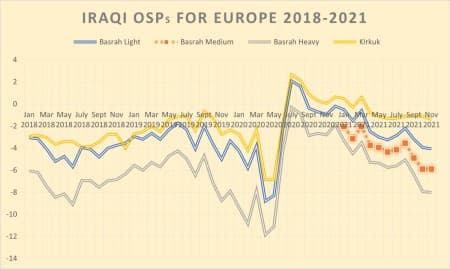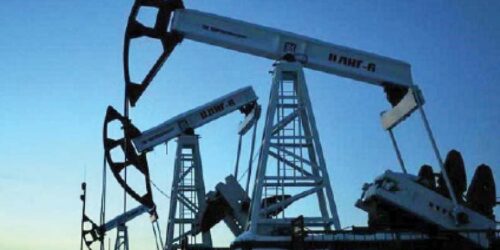he ongoing energy crunch has put a lid on what seemed to be the ideal bull run for this year’s autumn season – OPEC+ has maintained rigorous discipline even after it concluded a new supply cut agreement until end-2022, whilst demand for energy was growing much more robustly than anyone anticipated. Power consumption mandates, production cuts and electricity shortages have, however, become the new reality of October 2021, reshaping the overall market fundamentals of crude. Chinese buying, always presumed to restart at some point later this year, is now off the agenda, whilst India’s own post-third wave rally was ground to a halt by an unprecedented wave of power shortages. Against all this, Middle Eastern producers needed to calibrate their November 2021 OSPs very carefully.
Graph 1. Saudi Aramco Official Selling Prices in November 2021 for Asia (USD per barrel, vs ICE Bwave).

Source: Saudi Aramco.
Saudi Aramco has cut prices for Asia-bound cargoes in November 2021 by 10-50 cents per barrel, with the heaviest Arab Heavy stream seeing the most marked month-on-month change, dipping to a -$0.1 per barrel discount against Oman/Dubai. Aramco’s nuanced approach of cutting light streams the least makes sense for several reasons – cracks across the Asian petrochemical sector are still robust enough for grades with a high naphtha cut. Second, it will be predominantly Arab Heavy and Arab Medium that would be coming back on the back of Saudi Arabia complying with its gradually increasing OPEC+ production targets, i.e. ampler supply should generally necessitate a downward pricing pressure which Aramco already anticipates. Third, some Asian customers might be tempted to try out gas-to-oil switching amidst exorbitant LNG prices, therefore conducive pricing might potentially sway them in Aramco’s direction.
Graph 2. Saudi Aramco Official Selling Prices in November 2021 for Northwest Europe (USD per barrel, vs ICE Bwave).

Source: Saudi Aramco.
Similarly, the formula prices for Europe-bound cargoes were cut by $0.5-1 per barrel for Northwest Europe and by $0.3-0.6 per barrel for the Mediterranean, meaning that Saudi Aramco is ready to vie for a larger market share after the pricing rollover with October 2021 OSPs. The first OSP cut for Europe-bound cargoes took place already in September, the second month of OPEC+ supply increases, and despite a marginal increase in flows (to 680kbpd in September) the desired effect is still not yet there, Saudi Arabia still lacks some 100-150kbpd in exports to Europe compared to the pre-pandemic era.
Graph 3. ADNOC Official Selling Prices in 2017-2021 (USD per barrel).

Source: ADNOC.
The Singapore marker prices for front-month IFAD (ICE Futures Abu Dhabi) trading have established the November 2021 OSP for the UAE benchmark, the light sweet Murban, at $73.41 per barrel. Whilst the outright price is set by the exchange, ADNOC decides on other grades’ differentials to Murban and this month it has decided to keep them unchanged, for lack of a strong market hint to do otherwise. Murban is still yet to reach its pre-pandemic export levels of above 1 mbpd, averaging around 930kbpd in September as ADNOC’s voluntary production cuts see the last months of their implementation before they are finally tapered off in November, implying that from December 2021 onwards UAE production should not be curtailed by any voluntary production limit.
Whilst overall volumes of traded contracts failed to impress over September, Murban nevertheless managed to pull off a noteworthy feat – a spot cargo was offered at the IFAD against a differential to the exchange-traded monthly average and not vs the most frequently used Dubai crude assessment, showing the first real-life signs of how Murban might be undercutting the overall Dubai complex (when hedging Murban cargoes the buyer would buy the Brent-Dubai EFS spread which would see him selling Dubai futures). Meanwhile, despite the beneficial prices globally ADNOC has scaled back its downstream ambition by forgoing its plans to build a new 400kbpd refinery in Ruwais that was assumed to be operational by 2026 and providing Abu Dhabi with even bigger exposure to the petrochemicals segment.
Graph 4. Iraqi Official Selling Prices for Europe in 2018-2021 (USD per barrel).

Source: SOMO.
Seemingly eager to continue the pricing battle with Saudi Arabia, Iraq’s state oil marketing company SOMO mirrored the month-on-month changes of the Saudi NOC and cut the November OSPs of its three Basrah grades to Asian customers by 40-50 cents per barrel, with Basrah Heavy seeing the largest cut from October. This should help maintain firm interest in Iraqi barrels – after all, the Basrah Light-Arab Medium spread to its lowest in 5 years last month (at a -$0.60 per barrel discount) and will stay at the same level in November, too. In the meantime, SOMO might no longer offer Basrah Light cargoes for annual term allocations as its recently leaked message to buyers seems to suggest. Overall, the omission of Iraq’s lightest export stream should not really come as a surprise – if anything, with production getting increasingly tilted towards the heavier barrels, SOMO was never really capable of providing the market with true Basrah Light quality.
Graph 5. Basrah Light-Arab Medium spread in 2018-2021 (USD per barrel).

Source: SOMO.
With September recording the second-strongest month in terms of Asia-bound exports this year, Iraq has less to worry about firm Asian demand waning than it should rather focus on revitalizing European demand. Despite generous OSP cuts – for instance, the largest Iraqi stream Basrah Medium would be traded at the same -$5.90 per barrel discount to Dated BFO – export volumes are slow to pick up and have been lagging behind pre-pandemic levels quite tangibly. One ought to note that it is not merely a function of supply and demand, SOMO’s crackdown on re-trading and its stringent approach demonstrated vis-à-vis destination clauses contributed at least as much as market fundamentals did (i.e. Basrah barrels palpably more difficult to trade freely for those not having a term supply contract with SOMO).
Graph 6. Iranian Official Selling Prices for Asia in 2018-2021 (USD per barrel).

Source: NIOC.
Ever since the election of Ebrahim Raisi as Iran’s new president, the question of Teheran returning to the global crude markets anytime soon has lost traction. With Iran reportedly intent on putting forward additional demand beyond the already-negotiated commitments, the complexity of finding an outcome that would be mutually acceptable is almost too hard to imagine. For instance, the JCPOA negotiating team still failed to overcome one of its fundamental flaws, namely that Iran is negotiating with the EU, Russia and China, i.e. countries that were always in favour of maintaining the nuclear deal, whilst there have not been direct talks with the United States throughout the process, making it all but impossible to strike a harmonious note.

When it comes to Iranian OSPs for November-loading cargoes, Iran’s national oil company NIOC followed in the footsteps of Saudi Arabia and dropped its Asian formula prices by 35-40 cents per barrel, though Iranian Light did gain marginally vis-à-vis its more sulphurous Saudi peer Arab Light, now trading at a 1.10 per barrel premium to the Oman/Dubai average. The fact that Iran prefers to maintain its Asian prices on par with the mainstream trends might in fact reflect an overlooked sense of confidence as NIOC continues to export crude barrels to East Asian countries. Roughly two-thirds of all exports end up in China even though vessel-tracking data would suggest that Iran’s largest market outlet is Malaysia, averaging around 0.5mbpd in July-August (and might be the same for September once all the cargoes come out of their lurking).





